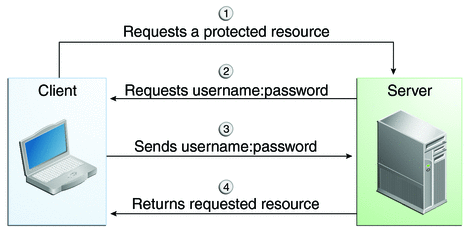HTTP Basic Authentication
Specifying HTTP basic authentication requires that the server request a user name and password from the web client and verify that the user name and password are valid by comparing them against a database of authorized users in the specified or default realm.
Basic authentication is the default when you do not specify an authentication mechanism.
-
A client requests access to a protected resource.
-
The web server returns a dialog box that requests the user name and password.
-
The client submits the user name and password to the server.
-
The server authenticates the user in the specified realm and, if successful, returns the requested resource.
When basic authentication is used, the following actions occur:
Figure 25–2 shows what happens when you specify HTTP basic authentication.
Figure 25–2 HTTP Basic Authentication

- © 2010, Oracle Corporation and/or its affiliates
